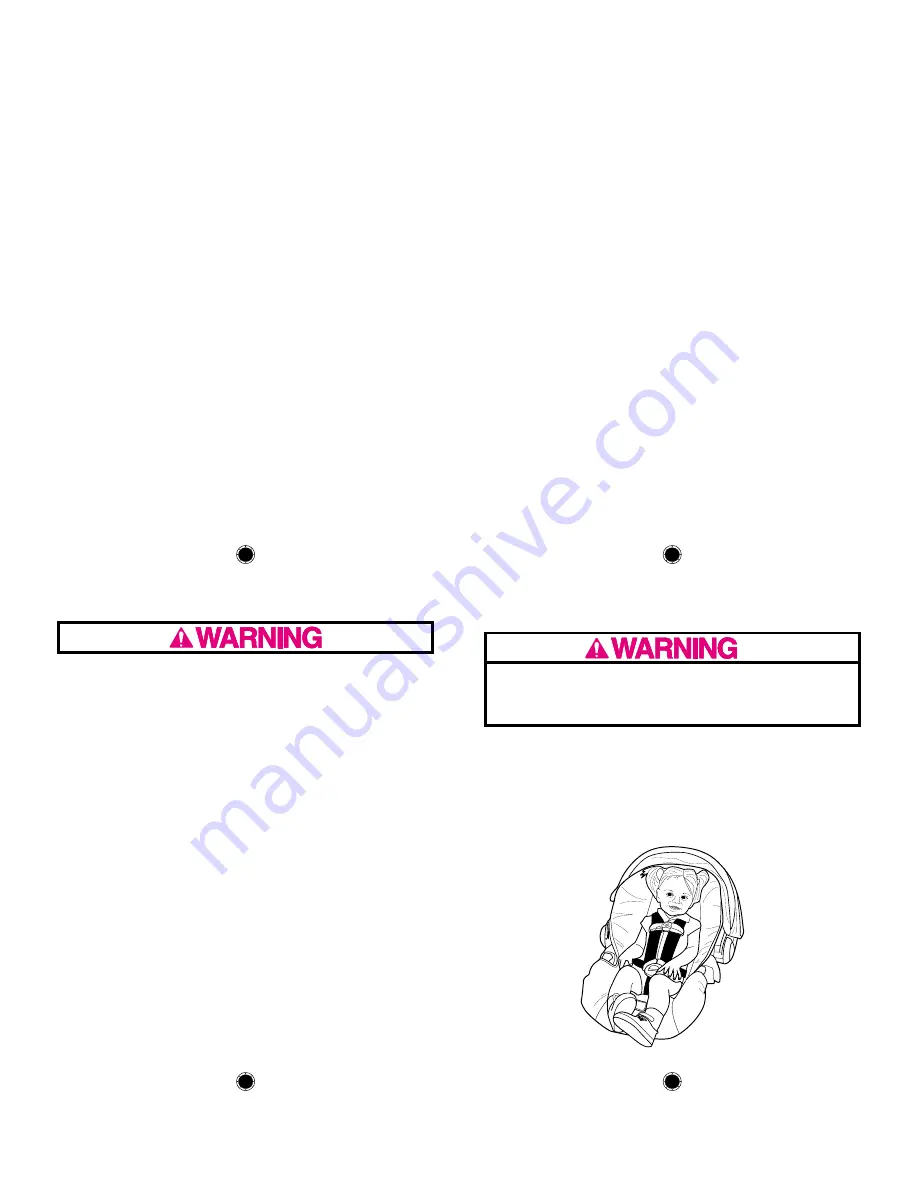
9
•
SOME SPECIAL NEEDS CHILDREN
, such as pre-term babies or
those who have tested positive for positional apnea, may be at
increased risk of suffering breathing or other difficulties in an infant
restraint. If your child has special needs, we recommend that you
have your physician or hospital staff evaluate your child and
recommend the proper infant restraint or car bed before using
this product.
•
According to accident statistics,
CHILDREN ARE SAFER
WHEN PROPERLY RESTRAINED IN REAR VEHICLE SEATING
POSITIONS, RATHER THAN FRONT SEATING POSITIONS.
For a
vehicle with a front passenger air bag, refer to your vehicle owner’s
manual as well as these instructions for infant restraint installation.
•
NEVER LEAVE YOUR CHILD UNATTENDED.
•
NEVER LEAVE AN INFANT RESTRAINT AND BASE UNSECURED
IN YOUR VEHICLE.
An unsecured infant restraint or base can be
thrown around and may injure occupants in a sharp turn, sudden
stop or crash. Remove it or make sure that it is securely belted in
the vehicle. If not using
LATCH,
make sure unsecured
LATCH
connectors are properly stored on base.
•
REPLACE THE INFANT RESTRAINT AND BASE AFTER AN
ACCIDENT OF ANY KIND.
An accident can cause damage to the
infant restraint that you may not be able to see.
•
STOP USING INFANT RESTRAINT AND BASE AND THROW IT
AWAY
after the date molded into the back of the infant restraint. “DO
NOT use this car seat after December (Year)”
•
DO NOT MODIFY YOUR INFANT RESTRAINT AND BASE
or use
any accessories or parts supplied by other manufacturers.
•
NEVER USE INFANT RESTRAINT AND BASE IF IT HAS
DAMAGED OR MISSING PARTS.
DO NOT use a cut, frayed or
damaged infant restraint harness, vehicle seat belt or LATCH belt.
•
THE INFANT RESTRAINT CAN BECOME VERY HOT IF LEFT IN
THE SUN.
Always touch the surface of any metal or plastic parts
before putting your child in the infant restraint.
•
THIS INFANT RESTRAINT CONFORMS
to all applicable Federal
Motor Vehicle Safety Standards and is certified for use in motor
vehicles and aircraft.
•
USE ONLY WITH STROLLERS THAT ARE PART OF THE GRACO
TRAVEL SYSTEM.
Refer to stroller owner’s manual for details about
how to attach the infant restraint to your stroller. If you do not have an
owner’s manual, please call toll-free, 1-800-345-4109 to obtain one, or
visit our website at www.gracobaby.com.
• Never use a Graco’s infant restraint with other manufacturer’s
strollers. May result in serious injury or death.
3.2 Warning for Use With a Stroller
10
3.3 Additional Warnings for Use as Carrier
11
•
FALL HAZARD:
Child’s movements can slide carrier.
NEVER
place carrier near edges of countertops, tables or other
high surfaces. Always stay within arms reach whenever carrier is
not on floor/ground.
BE SURE
handle locks into position before lifting carrier.
NEVER
place carrier on the top of a shopping cart.
•
SUFFOCATION HAZARD:
Infant carrier can roll over on soft
surfaces and suffocate child. Never place carrier on beds, sofas
or other soft surfaces.
•
STRANGULATION HAZARD:
Child can strangle in loose restraint
straps. Always use harness. Never leave child in carrier when straps
are loose or undone.
KEEP STRINGS AND CORDS AWAY FROM CHILD.
Strings and
cords can cause strangulation.
DO NOT
place carrier near a window where cords from blinds or
drapes can strangle a child.
DO NOT
hang strings on or over the carrier.
DO NOT
place items with a string around a child’s neck, such as
hood strings, pacifier cords, etc.
DO NOT
attach strings to toys.
12
3.4 Height and Weight Limits
Your child MUST meet the following requirements:
•
WEIGHT:
5-30 lbs. (2.3-13.6 kg)
AND
•
HEIGHT:
32 inches (81 cm) or less in height.
TO AVOID SERIOUS INJURY OR DEATH DO NOT USE THE
INFANT RESTRAINT WITH A CHILD LARGER OR SMALLER
THAN THE WEIGHT AND HEIGHT RANGE LISTED BELOW.
Page 3 of 11 Graco Safe Seat Infant (7/05)

























